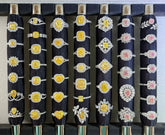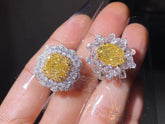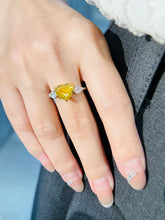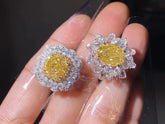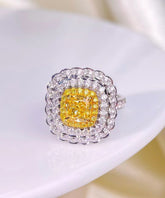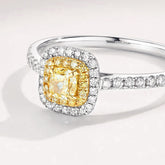Diamonds might be made of hair? Step inside the lab cultivating diamonds!
When it comes to diamonds, people often think of their toughness, brilliance, and eternity. They are gifts from nature, treasures buried in the for millions of years before coming to light. However, with the advancement of technology, a diamond can now be grown in a laboratory in just a few days. Today, let's learn about lab-grown diamonds!

Image source: LIGHT BOX JEWELRY official website
First of all, what is lab-grown diamond?
Lab-grown diamond is a type of polycrystalline diamond formed by the aggregation of diamond crystals with diameters ranging from 10 to 30 nanometers. It generally exhibits phosphorescence. Artificial synthesis of diamonds has a history of several decades. With the advancement of technology, not only industrial-grade diamond materials but also lab-grown diamonds with gem-quality characteristics have emerged. Today's lab-grown large single-crystal diamonds have reached a level where they can rival natural diamonds, and even surpass them in perfection. They are now also being used in the production of jewelry.

Image source: GIA official website
So, how are lab-grown diamonds produced?
High-pressure high-temperature method (HPHT method)
Also known as the temperature gradient method, temperature differential method, or static pressure catalyst method. Simply put, it involves using a tiny diamond 'seed' and allowing it to grow in a molten catalyst under high temperature and high pressure conditions. However, the metal atoms that constitute the catalyst may more or less enter the diamond lattice during this process. This method is the most widely used technique for synthesizing superhard materials in industrial production worldwide, and the majority of lab-grown diamonds are produced using this method.

Large single-crystal diamonds synthesized using the HPHT method (after cutting and polishing)
Chemical Vapor Deposition method (CVD method)
It is a process where substances in gaseous or vapor states react at the gas-solid interface to generate solid deposits. This technology has developed rapidly and offers significant advantages. Firstly, compared to the HPHT method, diamonds produced using the CVD method have higher purity because theoretically, high-purity diamonds can be synthesized by using high-purity gases. Secondly, it is possible to grow large single-crystal diamonds, and even multiple single crystals at once, which can significantly reduce production costs.

A large single-crystal diamond synthesized using the CVD method by the Carnegie Geophysical Laboratory in the United States, weighing 10 carats in its rough state, reduced to 5 carats after cutting and polishing.
Now let's take a look at the applications of lab-grown diamonds.
With the current maturity of lab-grown diamond technology, besides synthesizing yellow and colorless diamonds, people can also produce extremely rare blue and pink diamonds found in natural diamonds. Lab-grown large single-crystal diamonds are not only used to make conventional diamond jewelry such as rings, earrings, and necklaces, but they can also be used to create a special type of commemorative diamond known as 'hair diamonds' and 'cremation diamonds.'

Image source: ALGORDANZA official website
These diamonds are made from carbon extracted from the human body, typically from hair or cremated ashes. Carbon is extracted in a high-nitrogen, low-oxygen atmosphere, purified by heating it to extremely high temperatures to obtain graphite, and then synthesized into diamonds using the HPHT method. It is now possible to synthesize diamonds in colors such as orange-yellow, blue, deep red, and white. After completion, the diamonds are cut into various shapes according to customer preferences. Finally, a laser inscription, such as the name of the deceased, is engraved on the girdle of the diamond. Transforming the ashes of a loved one into memorial diamonds, crafted into jewelry for family members to wear, is not only a romantic and beautiful adornment but also a timeless tribute from family to the departed.

Image source: ALGORDANZA official website
Of course, as a special type of synthetic diamond, memorial diamonds made from cremated ashes entail extremely advanced technology and naturally command high prices. A 1-carat memorial diamond typically costs around 800,000 yuan, which is not only more expensive than regular synthetic diamonds but also pricier than natural diamonds.
Lab-grown diamonds are of excellent quality, with no visual differences from natural diamonds. So the question arises: How do we distinguish lab-grown diamonds from natural ones?
In the past, due to the less refined technology of lab-grown diamonds, diamond merchants could use a strong magnet to confirm whether a diamond was artificially cultivated. Because synthetic diamonds contain metal crystallizations left over from the cultivation process, a strong magnet can attract the diamond.

However, as lab-grown diamond technology continues to mature, the previous methods are no longer effective. Distinguishing them requires specialized testing equipment, so it's necessary to have professional appraisal organizations or laboratories conduct the assessment.
Of course, consumers need not worry. The certificate for lab-grown diamonds will clearly state that the diamond is 'Laboratory-Grown.' Therefore, when purchasing lab-grown diamonds, it is essential to ensure that it comes with certification from reputable organizations.

When it comes to jewelry, what are the prospects for lab-grown diamonds?
Today, more and more people are embracing synthetic diamonds. Surveys indicate that younger generations, particularly those after the millennials, are increasingly accepting of lab-grown diamonds. After all, as decorative jewelry, lab-grown diamonds shine just as brightly. Moreover, compared to natural diamonds of equivalent quality, they can be priced about 30% to 40% lower.

Image source: LIGHT BOX JEWELRY official website
From the perspective of jewelers, lab-grown diamonds have lower production costs and are more suitable for mass production and customization. Moreover, with the increasing awareness of environmental protection and the pursuit of renewable products, the popularity of sustainable jewelry is rapidly rising, and the demand for lab-grown diamonds continues to grow.

Global natural diamond giant De Beers launched a fashion jewelry company, LIGHT BOX JEWELRY, utilizing lab-grown diamonds as early as 2018, breaking its century-old tradition of exclusively using natural diamonds. Luxury brands such as Swarovski and Ada Diamonds have also entered the market, increasing their investments in lab-grown diamonds.

Image source: LIGHT BOX JEWELRY official website
As synthetic diamond technology becomes more mature, it will indeed have a certain impact on wearable and functional diamond jewelry, as consumers consider value for money. However, for collectible-grade diamonds, their natural origin and irreplaceable scarcity remain the core criteria determining diamond value. In today's market, natural diamonds still dominate.
FAQs
-
What is a lab-grown diamond?
-
Lab-grown diamonds are polycrystalline diamonds formed by the aggregation of diamond crystals with diameters ranging from 10 to 30 nanometers. They are created in a laboratory setting and exhibit phosphorescence.
-
How are lab-grown diamonds produced?
-
Lab-grown diamonds are produced using two main methods: High-Pressure High-Temperature (HPHT) method and Chemical Vapor Deposition (CVD) method. The HPHT method involves using a tiny diamond 'seed' and allowing it to grow in a molten catalyst under high temperature and high pressure conditions. The CVD method involves substances in gaseous or vapor states reacting at the gas-solid interface to generate solid deposits.
-
What are the applications of lab-grown diamonds?
-
Lab-grown diamonds are used to make conventional diamond jewelry such as rings, earrings, and necklaces. They can also be used to create commemorative diamonds known as 'hair diamonds' and 'cremation diamonds' from carbon extracted from the human body.
-
How do we distinguish lab-grown diamonds from natural ones?
-
Previous methods, like using a strong magnet, are no longer effective due to advancements in lab-grown diamond technology. Distinguishing them now requires specialized testing equipment, so it's necessary to have professional appraisal organizations or laboratories conduct the assessment. Lab-grown diamonds come with certification clearly stating their origin.
-
What are the prospects for lab-grown diamonds in the jewelry industry?
-
Lab-grown diamonds are increasingly accepted by younger generations and are priced about 30% to 40% lower than natural diamonds of equivalent quality. Jewelers benefit from lower production costs and the ability to mass-produce and customize lab-grown diamonds. The demand for lab-grown diamonds is growing due to increasing awareness of environmental protection and sustainable products.
-
What impact will lab-grown diamonds have on the diamond market?
-
Lab-grown diamonds may have an impact on wearable and functional diamond jewelry as consumers consider value for money. However, natural diamonds still dominate the market, especially for collectible-grade diamonds, where natural origin and scarcity are key factors determining value.
———— / END / ————
Abstract
Table of Contents
1.First of all, what is lab-grown diamond?
2.So, how are lab-grown diamonds produced?
3.Now let's take a look at the applications of lab-grown diamonds.
4.How do we distinguish lab-grown diamonds from natural ones?
5.When it comes to jewelry, what are the prospects for lab-grown diamonds?
